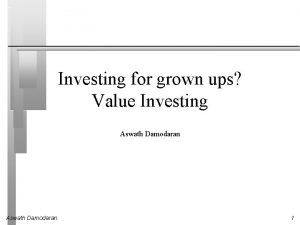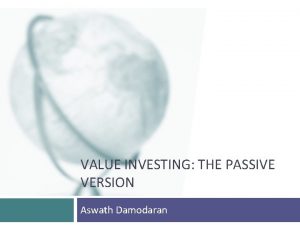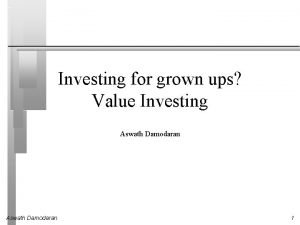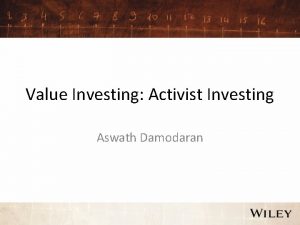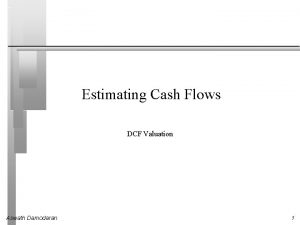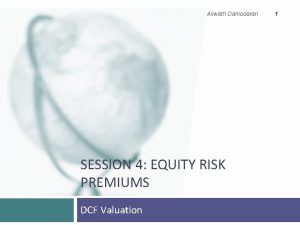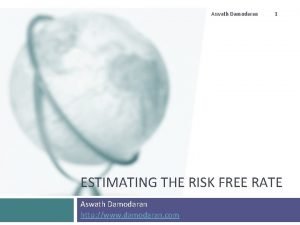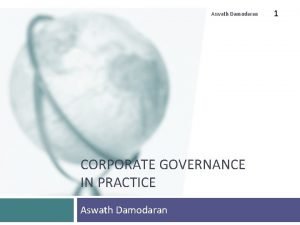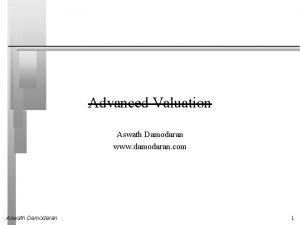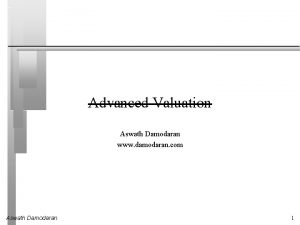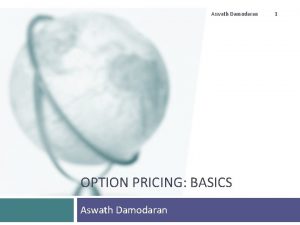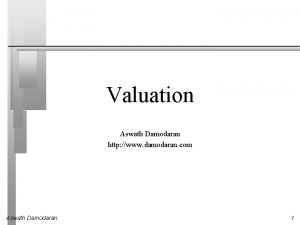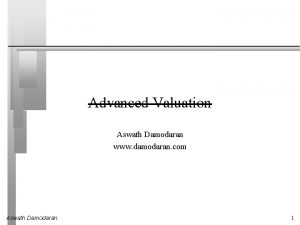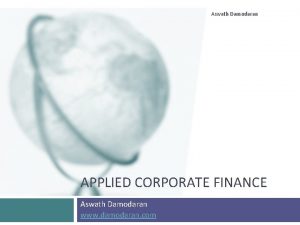ACTIVIST GROWTH INVESTING Aswath Damodaran The faces of















- Slides: 15

ACTIVIST GROWTH INVESTING Aswath Damodaran

The faces of activist growth investing • • • The when: Unlike activist value investing, which is usually directed at mature companies, late in the business life cycle, activist growth investing has to happen earlier in the cycle. The what: In its most common form, activist growth investing takes the form of providing capital to young, start up companies. That capital can be provided by venture capitalists of private equity investors. Another form? It is also possible for some activist growth investing to occur later in the life cycle, with firms that have growth opportunities that are not being exploited, but that is less common. 2

Investing in Private Equity: Forms VC: The first are venture capital funds that trace their lineage back to the 1950 s. One of the first was American Research and Development that provided seed money for the founding of Digital Equipment. LBOs: The second are leveraged buyout funds that developed during the 1980 s, using substantial amounts of debt to take over publicly traded firms and make them private firms. PE funds: The third are private equity funds pool the wealth of individual investors and invest in private firms that show promise. This has allowed investors to invest in private businesses without either giving up diversification or taking an active role in managing these firms. Pension funds and institutional investors, attracted by the high returns earned by investments in private firms, have also set aside portions of their overall portfolios to invest in private equity. 3

The Process of Venture Capital Investing Provoke VC interest: A young company’s capacity to do so will depend upon the business it is in and the track record of the managers in the firm. Valuation and Return Assessment: In the venture capital method, the earnings of the private firm are forecast in a future year, when the company can be expected to go public. Multiplied by an expected earnings multiple in a future year you get the exit or terminal value. This value is discounted back to the present at a target rate of return, which measures what venture capitalists believe is a justifiable return, given the risk that they are exposed to. Structuring the Deal: You have to negotiate two factors. 1. 2. 3. First, the private equity investor has to determine what proportion of the value of the firm he or she will demand, in return for the private equity investment. Private equity investors draw a distinction between what a firm will be worth without their capital infusion (pre-money) and what it will be worth with the infusion (post-money). Optimally, they would like their share of the firm to be based upon the pre-money valuation, which will be lower. Second, the private equity investor will impose constraints on the managers of the firm in which the investment is being made. This is to ensure that the private equity investors are protected and that they have a say in how the firm is run. 4

VC Pricing Approaches Recent pricing of the same company: Pricing is based on what VCs paid for the company (and priced it at) in the most recent venture capital round Pricing of similar private companies: Look at what investors are paying for similar companies in the “same space” (with all of the subjective judgments of what comprises “similar” and “same space”), scale this price to revenues, or lacking that, a common metric for that space, and price your company. Pricing of public companies: In the rare cases where a private business has enough operating substance today, in the form of revenues or even earnings, in a space where there are public companies, you could use the pricing of public companies as your basis for pricing private businesses. 5

And a forward variant 6

Post-deal Management Post-deal Management: Once the private equity investment has been made in a firm, the private equity investor will often take an active role in the management of the firm. Private equity investors and venture capitalists bring not only a wealth of management experience to the process, but also contacts that can be used to raise more capital and get fresh business for the firm. Exit: There are three ways in which a private equity investor can profit from an investment in a business. The first and usually the most lucrative alternative is an initial public offering made by the private firm. While venture capitalists do not usually liquidate their investments at the time of the initial public offering, they can sell at least a portion of their holdings once they are traded. The second alternative is to sell the private business to another firm; the acquiring firm might have strategic or financial reasons for the acquisition. The third alternative is to withdraw cash flows from the firm and liquidate the firm over time. This strategy would not be appropriate for a high growth firm, but it may make sense if investments made by the firm no longer earn excess returns. 7

The biggest risk in Venture Capital: Survival 8

The VC’s way of dealing with survival risk… The Venture Capital approach: In the venture capital approach, you hike the “discount rate” well above what would be appropriate for a going concern and then use this “target” rate to discount your “exit value” (which is estimated using a multiple and forward earnings). Value = (Forward Earnings in year n * Exit multiple)/ (1+ target rate)n In the VC valuation, the value is then kept in check by doing one or more of the following: Use conservative estimates of revenues and future earnings. Use “lower” estimates for the exit multiple, through both the “comparable” firm list and the choice of multiple. Use a high target rate of return to discount back the value. 9 9

VC target rates of return • • • Across the board, target rates of return demanded by VCs are significantly higher than the rates of return you see in most public company valuations or even in conventional private company valuations The target rates of return used by VCs will be different for different investments, depending upon where the young company is, in terms of product development and commercial success. In general, VC target rates of return are very high, well in excess of what investors demand in conventional investments. 10

Actual Returns- VCs and PE funds Annualized Returns on VC, PE and Public Market Investments 25. 00% 21. 20% 20. 00% 16. 20% 15. 10% 15. 00% 13. 30% 12. 90% 13. 00%12. 60% 10. 90%11. 20% 10. 90% 10. 00% 7. 30% 5. 90% 4. 20% 5. 00% 1. 40% 0. 00% 2015 2013 -2015 2011 -2015 VC Funds PE Funds 2006 -2015 2001 -2015 S&P 500 11

VC Returns, by Group: Updated 2018 2014 -2018 2009 -2018 1999 -2018 All VC 20. 89% 13. 14% 13. 80% 17. 93% Early Stage VC 22. 99% 14. 61% 14. 66% 86. 09% Late & Expansion Stage VC 19. 74% 9. 72% 13. 96% 9. 21% Multi-Stage VC 17. 65% 11. 89% 12. 40% 9. 34% S&P 500 9. 50% 10. 91% 15. 92% 6. 04% NASDAQ 9. 43% 12. 98% 17. 59% 5. 89% 12

And elite VCs stay elite… The most successful VCs not only earn higher returns than the top public market investors but that there seems to be more consistency in the VC business, insofar as the best of the VCs are able to generate higher returns across longer time periods. That would suggest that venture capitalists bring more durable competitive advantages to the investing game than public market investors. 13

Perhaps using these competitive advantages. . They are better pricers (relatively): While all of VC prices are undoubtedly wrong (because they are estimates), some of them are less wrong than others. You just have to be less wrong than everyone else and the chances of you doing that are greater in the VC pricing game. They can influence the pricing game: VCs can take a more active role in the companies that they invest in, from informally advising managers to more formal roles as board members, helping these companies decide what metrics to focus on, how to improve these metrics and how (and when) to cash in on them (from an IPO or a sale). They have better timing: To be successful, you not only have to time your entry into a business right but even more critically, time your exit from it. 14

Determinants of Success at Growth Investing 1. 2. 3. 4. 5. Pick your companies (and managers) well: Good venture capitalists seem to have the capacity to find the combination of ideas and management that make success more likely. Spread your bets: The rate of failure is high among private equity investments, making it critical that you spread your bets. The earlier the stage of financing – seed money, for example – the more important it is that you diversify. Support and supplement management: Venture capitalists are also management consultants and strategic advisors to the firms that they invest in. If they do this job well, they can help the managers of these firms convert ideas into commercial success. Protect your investment as the firm grows: As the firm grows and attracts new investment, you as the venture capitalist will have to protect your share of the business from the demands of those who bring in fresh capital. Know when to get out: Having a good exit strategy seems to be as critical as having a good entrance strategy. Know how and when to get out of an investment is critical to protecting your returns. 15
 Damodaran
Damodaran Damodaran value investing
Damodaran value investing Aswath damodaran value investing
Aswath damodaran value investing Aswath damodaran value investing
Aswath damodaran value investing Activist value investing
Activist value investing Aswath damodaran dcf
Aswath damodaran dcf Damodaran multiples
Damodaran multiples Damodaran country risk premium 2016
Damodaran country risk premium 2016 Aswath damodaran intrinsic value
Aswath damodaran intrinsic value Risk free rate aswath damodaran
Risk free rate aswath damodaran Aswath damodaran age
Aswath damodaran age Damodaran on valuation review
Damodaran on valuation review Www.damodaran
Www.damodaran Aswath damodaran
Aswath damodaran Startup valuation damodaran
Startup valuation damodaran Pbv
Pbv
